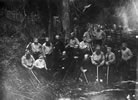Cambridge
Town 24 km south-east of Hamilton, with a 2013 population of 15,321. In 1864 the 3rd Waikato militia settled at Cambridge. It was named after Queen Victoria’s cousin, the Duke of Cambridge, then commander in chief of the British army.
Like Hamilton, Cambridge was divided by the Waikato River into two settlements, connected by a punt. The river was bridged by 1871 but, unlike Hamilton, the sides remained administratively separate for nearly 100 years. The south settlement, Leamington, did not amalgamate with Cambridge Borough until 1958.
A tale of two kings
When Cambridge got a new post office in 1908, the arched metal grille over the door commemorated the reigning monarch, King Edward VII. The post office was extended in 1936 and, as it gained another door, a matching grille was made for the new King Edward VIII. A short time later, he abdicated to marry Wallis Simpson. The post office, with its two grilles, is unique in New Zealand and probably in the world.
Cambridge began to flourish when first a road and then a branch railway were built from Hamilton. A borough by 1886, it rivalled Hamilton for the position of Waikato’s main town, but was outpaced in the next few decades.
Dairying was the main type of farming in the surrounding district, but sheep farming on the hill country, and horticulture, have become increasingly significant. The most noticeable change since 1945 has been the growth in numbers of thoroughbred racing studs. The success of Cambridge-bred horses and riders is celebrated in the Equine Statue and Equine Stars Walk of Fame on Victoria St.
Thoughtful planting of exotic trees in early days allowed Cambridge to call itself ‘town of trees’ in the late 20th century. It also has some picturesque timber buildings, including St Andrew’s Anglican church (1881) and the Cambridge Primary School (1879). The imposing town hall (1909) is bordered by Jubilee Gardens, which contain a clock tower and war memorial.
Hautapu
Farming locality 4 km north-west of Cambridge. The Cambridge Co-operative Dairy Company, established in 1901, had five factories in the rich dairying area around Cambridge by the 1950s, including one at Hautapu. In 2010 Fonterra owned a huge, modern dairy plant there.
Te Miro
Farming locality 15 km north-east of Cambridge. Te Miro estate was developed by the government after the First World War to settle returned servicemen. Te Miro Scenic Reserve has tawa, rimu, pukatea, rewarewa and, of course, miro trees.
Te Tāpui Scenic Reserve
Large reserve south-east of Te Miro, including two old volcanic cones, Te Tāpui (495 m) and Maungakawa (494 m). The Piakonui Stream, which drains the thickly forested reserve, is a tributary of the Piako River. A loop track leads to a lookout tower with views to the Kaimai Range and Firth of Thames. In the early 1890s King Tāwhiao established his parliament house in this area, but it burned down in 1908.
Maungakawa Scenic Reserve
Reserve north-east of Cambridge. The name can be confusing, as Maungakawa mountain is actually located in Te Tāpui Scenic Reserve. Maungakawa Scenic Reserve, established in 1963, got its name because it was once part of the large Maungakawa estate. The hill here, Pukemako, is also known as Sanatorium Hill. From the summit there are panoramic views. The Gudex Memorial Park, within the reserve, commemorates the conservation work of M. C. Gudex.
In 1868 surrounding land was purchased from Māori owners by Daniel Thornton, and after his death a substantial residence was built on Pukemako. Between 1903 and 1922 it was a government-owned tuberculosis sanatorium, Te Waikato.
Lake Karāpiro
Artificial lake of 8 sq km, formed behind the Karāpiro hydro dam, south-east of Cambridge on the Waikato River. Beneath its waters lies the Horahora power station, completed in 1913 to supply the Waihi Gold Mining Company in the Bay of Plenty. It was flooded in 1947 during the process of bringing the Karāpiro dam into use. Lake Karāpiro is used for rowing, water-skiing and powerboating. It has been the venue for national and international competitions, and hosted the 2010 World Rowing Championships.

